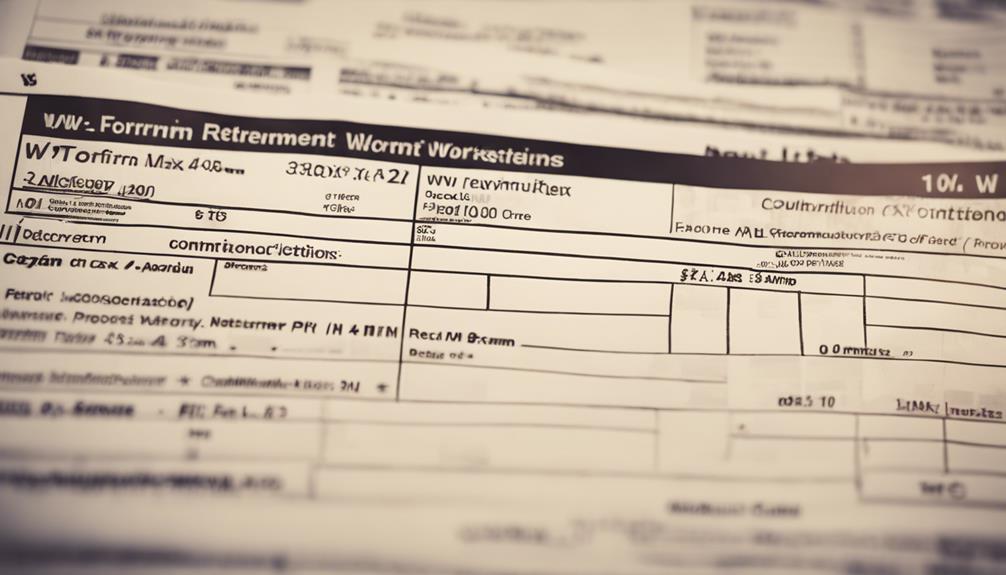To locate your retirement plan information on your W2 form, refer to Box 13. This section indicates whether you are enrolled in a retirement plan and specifies the type of contributions made. Being familiar with this information can assist in tax planning and financial planning for the future. It is important to review Box 13 for accurate reporting and to distinguish between pre-tax (found in Box 12) and post-tax contributions. Pre-tax contributions can help lower taxable income. For a deeper understanding of your retirement plan details on your W2 form and how to maximize benefits, paying attention to Box 13 is a good place to begin.
Key Takeaways
- Locate Box 13 on W2 for retirement plan details.
- Box 13 reveals participation and contribution nature.
- Check for pre-tax or post-tax contributions.
- Verify for accurate tax deductions and planning.
- Understanding Box 13 impacts financial decisions.
Locating Box 13 on W2
When reviewing your W2 form, we typically locate Box 13 to determine your participation in a retirement plan. This box holds vital information about whether you're actively contributing to a retirement savings account through your employer.
Knowing your retirement plan status is important as it can impact your tax deductions and overall financial planning. By checking Box 13, you can confirm whether your contributions are pre-tax or post-tax, which affects how your retirement savings grow over time.
Understanding this information is key to making informed decisions about your financial future and ensuring you're maximizing the benefits of your retirement plan. If you have any uncertainties about interpreting the details in Box 13, it's advisable to seek guidance from a tax professional who can provide expert advice tailored to your specific situation.
Ultimately, being aware of your retirement plan status can help you strategize effectively for your tax filings and long-term financial goals.
Understanding Retirement Plan Participation

When considering retirement plan participation, it's vital to understand eligibility, contribution options, and the vesting schedule. These aspects play a significant role in determining how your retirement savings will grow over time.
We'll break down each point to help you navigate your retirement planning more effectively.
Retirement Plan Eligibility
Understanding retirement plan participation is essential for maximizing tax benefits and financial security in the future. Here are four key points to keep in mind regarding retirement plan eligibility:
- Box 13 Significance: Box 13 on your W-2 indicates your participation in a retirement plan.
- Tax Impact: Checking the retirement plan box can influence your tax filing and deductions.
- Contribution Basis: The box helps you identify if contributions are made on a pre-tax or post-tax basis.
- Verification Importance: Verification of retirement plan participation is vital for accurate tax reporting.
Contribution Options Overview
Exploring the various contribution options available is essential to understanding your retirement plan participation. When reviewing Box 13 on your Form W-2, the retirement plan indicator provides insight into your retirement savings. It's important to comprehend how checking this box impacts your tax filing and deductions.
The retirement plan indicator helps distinguish between pre-tax and post-tax contributions, influencing your taxable income. Seeking advice from a tax professional can clarify the implications of your retirement plan participation. Accurate reporting guarantees compliance with tax regulations and maximizes your benefits.
Vesting Schedule Explanation
How does the vesting schedule impact my retirement benefits? Understanding the vesting schedule in your retirement account is crucial for maximizing your benefits. Here's what you need to know:
- Vesting schedule determines how much of your employer's contributions you're entitled to keep.
- It indicates the portion of the retirement account balance that belongs to you if you leave the company.
- Vesting can be immediate or gradual over a specific period, such as three to five years.
- Some plans offer cliff vesting, where you become fully vested after a certain period.
Knowing your vesting schedule helps you plan for the future and make the most of your retirement savings.
Importance of Checking Box 13

Marking Box 13 on your W2 is essential because it offers valuable information about your involvement in a retirement plan. This box plays a key role in establishing your eligibility for certain tax deductions and indicates whether contributions were made by you or your employer.
Grasping the specifics in Box 13 is vital for ensuring precise reporting of your retirement plan on your tax return.
Box 13 Explanation
When reviewing your Form W-2, it's important to pay close attention to Box 13 as it indicates your participation in a retirement plan. Understanding the implications of checking this box is essential for accurate tax filing.
- Tax Filing Impact: Checking Box 13 affects your tax filing and deductions.
- Contribution Verification: Helps verify if contributions are pre-tax or post-tax.
- Professional Guidance: Consult a tax professional for retirement plan implications.
- Accuracy Is Key: Accurate reporting on tax forms is crucial based on Box 13 information.
Retirement Contribution Details
Reviewing Box 13 on your Form W-2 provides valuable insights into your retirement contributions and their impact on tax filing. This section indicates your participation in a retirement plan, influencing potential deductions.
By checking Box 13, you can discern if your contributions are pre-tax or post-tax, essential for accurate tax reporting. Understanding these details is key to optimizing your retirement savings strategy.
If you're unsure about interpreting this information, consider consulting a tax professional for guidance. Being proactive in verifying your retirement plan details on your W-2 can lead to better financial planning and tax efficiency.
Stay informed about Box 13 to make informed decisions regarding your retirement contributions.
Differentiating Pre-tax and Post-tax Contributions

Differentiating between pre-tax and post-tax contributions on your W-2 can have significant implications for your retirement savings strategy. Understanding the distinction can help you make informed decisions about your finances and plan effectively for the future.
Here are some key points to keep in mind:
- Pre-tax contributions, such as 401(k) elective deferrals, are typically indicated in Box 12 of the W-2 with specific codes like D.
- On the other hand, post-tax contributions may not be explicitly separated on the W-2 and are often included in the total wages.
- Checking Box 13 on your W-2 can provide clarity on whether your contributions are pre-tax or post-tax.
- Pre-tax contributions reduce your taxable income, potentially lowering your current tax liability and maximizing your tax benefits.
Being aware of the nature of your contributions can help you optimize your retirement savings strategy and take full advantage of the benefits offered by your retirement plan.
Consulting a Tax Professional

When it comes to understanding your retirement plan details, consulting a tax professional is crucial. They can offer expert tax advice, provide professional guidance, and give you specialized recommendations tailored to your specific situation.
Expert Tax Advice
Seeking advice from a tax professional can greatly assist in optimizing your retirement plan benefits. When consulting a tax expert regarding your retirement plan, consider the following:
- Tax Implications: Understand how contributions impact your taxes.
- Deduction Optimization: Learn how to maximize tax deductions through your retirement plan.
- Contribution Clarification: Verify contributions are accurately reported for tax purposes.
- Benefit Maximization: Get guidance on how to make the most of your retirement plan benefits.
Consulting a tax professional helps you navigate the tax implications of your retirement plan effectively, leading to better financial outcomes in the future.
Professional Guidance Available
For those managing complex retirement plan details, consulting a tax professional can provide invaluable guidance and clarity. A tax professional can help guarantee accurate understanding of your retirement plan contributions and provide insights into the tax implications associated with them. Seeking advice from a tax professional can optimize your tax filing based on your retirement plan information, potentially saving you money. Professional guidance also ensures that you accurately report your retirement plan details on your tax forms, avoiding any errors or complications. Below is a table to showcase the benefits of consulting a tax professional for assistance with your retirement plan contributions:
| Benefits of Consulting a Tax Professional |
|---|
| 1. Clarity on retirement plan contributions |
| 2. Optimization of tax filing |
| 3. Accurate reporting on tax forms |
| 4. Insights into tax implications |
| 5. Money-saving opportunities |
Get Specialized Recommendations
Consulting a tax professional can provide tailored recommendations on optimizing your retirement plan contributions based on personalized advice. Here are four reasons why seeking specialized recommendations from a tax professional can benefit employees dealing with retirement plans and Form W-2:
- Customized Strategies: Tax professionals can create personalized strategies that align with your financial goals.
- Tax Implications Clarity: They can clarify the tax implications of your retirement plan contributions, ensuring accurate reporting.
- Pre vs. Post-Tax Verification: Professionals can verify if your contributions are pre-tax or post-tax, impacting your tax obligations.
- Optimal Financial Planning: By understanding the tax implications, you can make informed decisions for better financial planning.
Common Errors in Box 13 Reporting

Accuracy in reporting retirement plan participation in Box 13 of your W-2 is vital for tax purposes. Errors in reporting can lead to issues with tax deductions and filing.
One common mistake is inaccurately including box 13 wages, which should only reflect retirement contributions made throughout the year. Another error is failing to differentiate between pre-tax and post-tax contributions, impacting the tax treatment of these funds.
To guarantee correct reporting, it's advisable to consult a tax professional who can provide accurate guidance and assistance. Precise details in Box 13 are essential for the completion of your tax forms.
Active Participant Status

Understanding one's active participant status in a retirement plan is essential for determining tax implications and contribution deductibility. When looking at Box 13 on your W-2 form, you can quickly ascertain if you're deemed an active participant in a retirement plan.
Here are some key points to ponder regarding active participant status:
- Tax Treatment: Checking the retirement plan box in Box 13 helps the IRS determine how your contributions should be taxed.
- Contribution Deductibility: Your active participant status can impact the deductibility of your traditional IRA contributions.
- Retirement Savings Involvement: Box 13 assists in comprehending the level of your involvement in retirement savings.
- Planning Ahead: Knowing your active participant status can help you make informed decisions about your retirement planning and overall financial future.
Box 12 Codes for Retirement Plans

Moving from understanding active participant status on your W-2, we now shift our focus to the significance of Box 12 Codes for Retirement Plans. Code D in Box 12 indicates elective deferrals under a 401(k) plan, while Code E signifies the amount of salary deferred under a 403(b) agreement. These codes play a vital role in understanding the specific retirement plan contributions reflected on your W-2 form. To provide a clearer picture, here is a breakdown of some common Box 12 codes for retirement plans:
| Code | Description |
|---|---|
| D | Elective deferrals under a 401(k) plan |
| E | Amount of salary deferred under a 403(b) agreement |
| H | Salary deferred to a section 501(c)(18)(D) plan |
Filing Form W-2 and Form W-3

When filing Form W-2 and Form W-3, employers are mandated to provide accurate information regarding their employees' earnings. Here's a quick guide to help you understand this essential process:
- Submission Deadline: Form W-2 must be submitted by January 31 each year to guarantee timely processing and avoid penalties.
- Tax Withholding: Employers report tax withholding amounts on Form W-2, which is important for employees to accurately file their taxes.
- Social Security Administration Reporting: FICA taxes are reported to the Social Security Administration using Form W-2, aiding in the calculation of social security benefits for employees.
- Employee Benefit: The information on Form W-2 is essential for employees, as it provides a detailed overview of their earnings and deductions, helping them plan for their financial future effectively.
Ensuring the accuracy and timeliness of Form W-2 submissions is essential for both employers and employees to maintain compliance with tax regulations and facilitate smooth financial planning.
Additional Resources and Guidance

Seeking further assistance in managing retirement plans effectively? When maneuvering the complexities of your compensation plan and understanding the implications it has on your taxes, it's essential to have access to reliable resources and guidance.
If you're unsure about the information provided on your Form W-2 regarding your retirement plan participation, consider consulting a tax professional. They can offer expert advice on how your contributions, whether pre-tax or post-tax, affect your tax filing and potential deductions.
Ensuring the accurate reporting of your retirement plan details is essential for a smooth tax process. By seeking additional resources and guidance, you can make informed decisions about your retirement plan and maximize its benefits.
Stay informed, stay proactive, and make the most of your retirement planning with the right support at your fingertips.
Frequently Asked Questions
Where Is Retirement Plan on W-2?
To find your retirement plan on your W-2, look in box 13. This box shows if you're actively participating in a retirement plan. It helps with tax deductions and credits.
Box 13 details the type of retirement plan you have. Understanding box 13 is crucial for accurate tax filing related to retirement savings.
What Does Box 14 of W-2 Say About Retirement?
Box 14 of your W-2 can contain important info about retirement plans like 'RET PLAN,' '401(k),' or 'Pension.' This section sheds light on extra compensation tied to retirement benefits. Employers put specific codes here that can affect your taxes.
It's essential to check Box 14 for any retirement plan data when filing taxes correctly.
How Do I Know What Retirement Plan I Have?
When determining your retirement plan, refer to your W-2 Box 13 for indicators like active participant status in various plans. Different codes correspond to specific retirement plans under different IRS sections.
Understanding this status is essential for tax implications and deductions. Be sure to check your Box 13 for accurate information on your retirement plan.
What Does DD in Box 12 Mean on W-2?
DD in Box 12 of your W-2 denotes the total cost of employer-sponsored health coverage. It's there to help you understand the value of the health benefits provided by your employer.
This amount, reported under Code DD, isn't taxable and serves as transparency on healthcare benefits, as mandated by the Affordable Care Act.
It's essential for employers to report this information on your W-2 form.
Conclusion
To sum up, locating your retirement plan information on your W2 can be a straightforward process once you understand where to look. By checking Box 13 and understanding the different codes and contributions, you can verify you're on track for your future financial security.
Remember to consult a tax professional for guidance and make sure to file your forms accurately to avoid any potential issues. Stay informed and proactive in managing your retirement savings.










